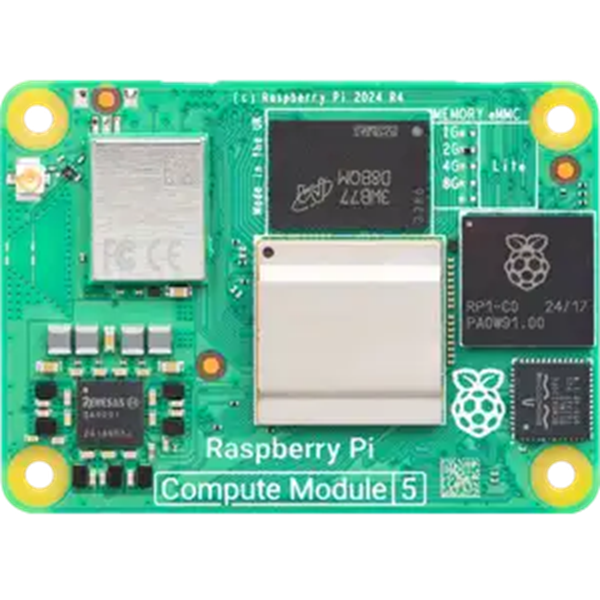Raspberry Pi Compute Module 5 (CM5) is the latest iteration in the Raspberry Pi’s Compute Module series, aimed at providing high performance, connectivity, and customization for industrial, embedded, and IoT applications. Here are some key details:

- Form Factor: The Compute Module 5 continues the SODIMM-style form factor, ensuring compatibility with existing Compute Module carrier boards. It measures approximately 67.6mm x 31mm.
- Processor: It features a Broadcom BCM2712 quad-core 64-bit ARM Cortex-A76 processor, clocked at 2.4GHz. This represents a significant leap in processing power over its predecessors, providing exceptional performance for demanding applications.
- Memory: The CM5 comes with options for 4GB, 8GB, or 16GB of LPDDR4X SDRAM, offering scalable memory solutions to suit various project requirements.
- Wireless Connectivity:
- Dual-band 802.11ac Wireless LAN (WLAN) with MIMO, supporting both 2.4GHz and 5GHz bands for fast and reliable internet access.
- Bluetooth 5.0 with BLE, enabling efficient communication with wireless peripherals.
- I/O Interfaces:
- Integrated:
- Two MIPI DSI display ports for connecting displays.
- Two MIPI CSI camera ports for camera modules.
- PCIe 2.0 interface for high-speed peripheral connectivity.
- Gigabit Ethernet over PCIe, supporting Power-over-Ethernet (PoE) with additional hardware.
- External:
- When used with a carrier board:
- 40-pin GPIO header, providing access to various I/O pins, including UART, I2C, SPI, PWM, and more.
- USB 3.0 and USB 2.0 ports for connecting peripherals.
- HDMI output for video display.
- Audio output.
- SD card slot for storage.
- When used with a carrier board:
- Integrated:
- Storage:
- Onboard eMMC storage options: 16GB, 32GB, or 64GB.
- Support for external microSD card storage.
- Potential support for NVMe SSDs via the PCIe interface.
- Power: Requires a 5V power supply, with power management capabilities integrated into the carrier board.
- Price: The Compute Module 5 is priced according to its memory, storage options, and enhanced features, reflecting its industrial-grade capabilities.
- Usage:
- Industrial Automation: Suitable for controlling complex machinery, robotics, and other automated systems requiring high performance.
- Embedded Systems: Ideal for applications needing high-performance computing, like digital signage, edge computing, and industrial control systems.
- IoT: Perfect for IoT gateways, data collection, and processing nodes in large-scale IoT deployments.
- Development: A platform for developers and companies looking to integrate powerful computing into their products or projects.
Key Advantages:
- Performance: The Cortex-A76 processor provides a significant boost in processing power, enabling more complex and demanding applications.
- Scalability: Multiple memory and storage options cater to different project needs and budgets.
- Improved Connectivity: Faster USB, dual HDMI, PCIe, and Gigabit Ethernet offer versatile connectivity options.
- Customization: Designed for use with custom carrier boards, allowing for specific I/O configurations tailored to the application.
- Reliability: Built with industrial-grade components, ensuring longevity and stability in harsh environments.
Limitations:
- Cost: The advanced features and industrial-grade components make it more expensive than consumer Raspberry Pi models.
- Learning Curve: Its use often requires knowledge of carrier board design or familiarity with existing carrier board options.
- No Built-in USB Ports: Unlike consumer models, it relies on carrier boards for USB connectivity, which might require additional setup.
The Raspberry Pi Compute Module 5 represents a significant evolution in the Compute Module lineup, offering performance and features that rival or exceed many low-end desktop computers. Its design allows for seamless integration into systems where size, power efficiency, and computational power are critical, making it an excellent choice for companies and developers looking to leverage Raspberry Pi technology in their industrial, professional, or IoT projects.
Documents
- Raspberry Pi Compute Module 5 product brief
- Raspberry Pi Compute Module 5 datasheet
- Raspberry Pi Compute Module 5 design files
Compliance
Raspberry Pi Compute Module 5 has undergone extensive compliance testing and meets a number of regional and international standards.
View and download relevant certificates and conformity documents.
If you require any further information regarding compliance, please contact us at compliance@raspberrypi.com
The Adopted Trademarks HDMI®, HDMI High-Definition Multimedia Interface, and the HDMI Logo are trademarks or registered trademarks of HDMI Licensing Administrator, Inc. in the United States and other countries.
